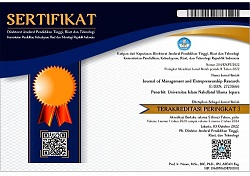About the Journal
Table of content
 Aims & Scope
Aims & Scope Open Access Policy
Open Access Policy General Guidelines
General Guidelines Structure of the Article
Structure of the Article Format Figures and Tables
Format Figures and Tables Editorial Contact
Editorial Contact Ethics Statement
Ethics Statement Similarity Checker
Similarity Checker License
License
Aims & Scope
Small, medium and large businesses require integrated management from various fields such as finance, marketing, human resources, operational and good governance, which are expected to improve business competitiveness. Journal of Management and Entrepreneurship Research over to who have manuscripts focused on finance, marketing, human resources, business operations, corporate governance, small and medium enterprises as well as entrepreneurship related to micro, meso, and macro phenomena. All reports correspond to the development, engineering, and implementation of all types of businesses. Only articles with contributions will be published. The scope of the journal includes empirical and theoretical articles related to:
Open Acces Policy
Journal of Management and Entrepreneurship Research is an open access journal which means that all contents is freely available without charge to the user or his/her institution. Users are allowed to read, download, copy, distribute, print, earch or link to the full text of the articles, or use them for any other legal purpose, without seeking the prior permission of the publisher or author. This is consistent with the BOAI definition of open access. Use and distribution in any medium is permitted, provided the author and the journal are properly credited.
Open Access publications are more likely to be discovered, read, cited, and used for future research than those published in closed journals, and we believe it is in the best interests of authors and their parent institutions, as well as the journals themselves, to make all our content freely available and reusable.
The Author’s Guideline of Journal of Management and Entrepreneurship Research since the publication year of 2020
Complete guidelines for preparing and submitting your manuscript to this journal are provided below.
Journal of Management and Entrepreneurship Research (JMER) is a peer-reviewed scientific journal. JMER is published by Universitas Islam Nahdlatul Ulama Jepara (UNISNU Jepara). JMER starts publication in June 2020 with a frequency of twice a year (June and December).
We accept manuscripts that fit the aims and scope of our journal. Make sure the manuscript submitted has been prepared in accordance with our technical requirements and takes into account the academic code of ethics. The manuscript is written according to our template. Manuscripts must be presented in English clearly. We will reject submissions not prepared according to our requirements. Please read the guidelines for authors, article templates and copyright.
As part of the submission process, authors are required to check off their submission's compliance with all of the following items, and submissions may be returned to authors that do not adhere to these guidelines.
The Manuscript General Guidelines
The submission is a original research paper. Occasionally published review articles summarising existing knowledge are accepted only if they are based on a systematic literature review. Manuscript must not exceed the required size of at least 4,000 words and a maximum of 8,000 words including tables, pictures, graphics, references, and appendixs. The manuscript is typed in text format (.doc / .docx), A4 size (21 x 29.7 cm) with top, right, bottom, and left margins of 2.5 cm each, spaced 1 using Times New Roman 11pt, except section titles and chapters 12pt, abstracts 10pt, and 9pt for tables. The distance between paragraphs one and the next 6pt. The manuscript consists of separate sections and does not use encoding or numbering both sections and subsections. For more detailed information, please download the article template that we have provided. Download.
Structure of the Article
-
The title of the manuscript. The title should be informative and be written both briefly and clearl, must be appropriate to the issue to be discussed in the manuscript. The article title does not contain any uncommon abbreviation. The article title should be written no more than 20 words, Times New Roman font size of 12pt, bold and center. An abstract should be a brief summary of significant items of the main paper.
-
Abstract. Authors must supply a structured abstract in their submission, set out under 4-7 sub-headings :
- Objective (mandatory)
- Research Design & Methods (mandatory)
- Findings (mandatory)
- Research implications (if applicable)
- Practical implications (if applicable)
- Social implications (if applicable)
- Recommendations (if applicable)
- Contribution & Value Added (mandatory)
Maximum is 250 words in total (including keywords and article classification), font Times New Roman 10 pt.Authors should avoid the use of personal pronouns within the structured abstract and body of the paper (e.g. "this paper investigates..." is correct, "I investigate..." is incorrect). Add Journal of Economic Literature (JEL) classification under the keywords, see the JEL Code Guide. -
Introduction. In the introduction section, context of the research should be established, the purpose and/or hypothesis that was investigated should be stated. The information on previous research on the subject can be included either in Introduction, or in the following section. Also, the main idea, importance, novelty, etc. can be indicated in this section. Use style Paragraph body, Times New Roman 11 pt, and line spacing single.
-
Literature Review. A literature survey, revealing all important authors dealing with the topic of the article. Use style Paragraph body, Times New Roman 11 pt, and line spacing single. Use subsections if needed with the title subsection with Times New Roman 11pt, bold, align left, and line spacing single.
-
Methods. The method is implemented to solve problems, including analytic methods. The methods used in the problem solving of the research are explained in this part. Use style Paragraph body, Times New Roman 11 pt, and line spacing single.
-
Finding. Finding should be clear and concise. If the paper requires a table or image, use formaton template.
-
Discussion. Discussion should explore the significance of the results of the work, not repeat them.
-
Conclusion. Presents conclusion of paper, based on results and analysis described in previous section. Conclusion can also including research implications, limitations and recommendations for future research.
- Acknowledgement (if Needed). containing a thank you to those who deserve (donors/sponsors), materials contributor, and research facilities.
-
References. References Style use American Psychological Association (APA) 6th Edition. We recommend using the Mendeley reference application management. The bibliography must include more than 20 scientific references. The bibliography must include at least 5 references indexed in Scopus or Web of Science. Recent studies published for the last five years must be included in references. Other than English literature should be kept to the minimum. We advise to use no more than 20% of references written in non‐English languages (unless the country‐specific article). Articles based only on Your own domestic literature (in your native language, not English) will be rejected. Examples of references are as follows:
Abor, J. Y., Agbloyora, E. K., & Kuipo, R. (2014). Bank Finance and Export Activities of Small and Medium Enterprises. Review of Development Finance, 4(2), 97–103. https://doi.org/10.1016/j.rdf.2014.05.004
Achtziger, A., Hubert, M., Kenning, P., Raab, G., & Reisch, L. (2015). Debt Out Of Control: The Links Between Self-Control, Compulsive Buying, and Real Debts. Journal of Economic Psychology, 49(8), 141–149. https://doi.org/10.1016/j.joep.2015.04.003
Bruderl, J., Preisendorfer, P., & Ziegler, R. (1992). Survival Chances of Newly Founded Business Organizations. American Sociological Review, 57(2), 227–242. https://doi.org/10.2307/2096207
Hogarth, J. M., & Hilgert, M. A. (2002). Financial Knowledge, Experience, and Learning Preferences: Preliminary Results from a New Survey on Financial Literacy. Proceedings of the American Council on Consumer Interests 2002 Annual Conference, 48, 1–7. https://doi.org/10.1054/arth.2001.23714
Format Figures and Tables
Editorial Contact:
JMER Editor Team
Dekanat Building, Faculty of Economics and Business, Universitas Islam Nahdlatul Ulama Jepara
Jl. Taman Siswa No. 9 Kauman Tahunan, Jepara, Jawa Tengah, Indonesia 59451
e-mail: jmer@unisnu.ac.id, website : https://journal.unisnu.ac.id/jmer/
Contact person:
Dewi Nur Maulidiyah
0895-3781-99623 (Whatsapp)
______________________________
Ethics Statement
Journal of Management and Entrepreneurship Research (p-ISSN: 2723-1658; e-ISSN: 2723-1666) is a peer reviewed journal published by Universitas Islam Nahdlatul Ulama Jepara which is committed to the highest standards of publication ethics and takes possible actions to restrict publication malpractices. This statement clarifies the ethical act of all parties involved in publishing articles in this journal, including authors, editor-in-chief, associate editors, editor members, reviewers, and publishers. Our ethical statements are based on COPE's Best Practice Guidelines for Journal Editors. Our responsibility is to publish original work of value to the intellectual community in the best possible form and to the highest possible standards. We expect similar standards from our reviewers and authors. Honesty, originality, and fair dealing on the part of authors, and fairness, objectivity, and confidentiality on the part of editors and reviewers are among the critical values that enable us to achieve our goal. Journal of Management and Entrepreneurship Research is committed to following best practices on ethical matters, errors, and retractions, and to provide a legal review if necessary. Read more.
Fundamental errors in published works
When an author discovers a significant error or inaccuracy in his/her own published work, it is the author’s obligation to promptly notify the journal editor or publisher and cooperate with the editor to retract or correct the paper.
Similarity Checker
Journal of Management and Entrepreneurship Research did not receive a journal that contains elements of plagiarism. We will check the manuscripts with the tolerance 20% similarity using Plagiarism Checker X
License
JMER is using CC BY license
























